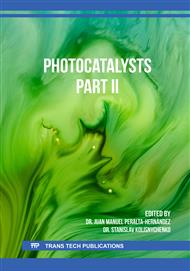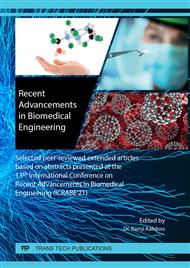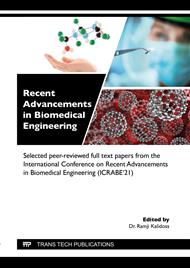[1]
R. Rathinam, M. Govindaraj, K. Vijayakumar, S. Pattabhi. Decolourization of Rhodamine B from aqueous solution by electrochemical oxidation using graphite electrodes. Desalin. Water Treat. 57 (2016) 16995–17001.
DOI: 10.1080/19443994.2015.1086960
Google Scholar
[2]
X. Li, T. Xia, C. Xu, J. Murowchick, X. Chen. Synthesis and photoactivity of nanostructured CdS–TiO2 composite catalysts, Catal. Today. 225 (2013) 64–73.
DOI: 10.1016/j.cattod.2013.10.086
Google Scholar
[3]
R. Rathinam, M. Govindaraj, K. Vijayakumar, S. Pattabhi. Removal of colour from aqueous rhodamine b dye solution by photoelectrocoagulation treatment techniques. J Eng Sci Res App. 1 (2015) 1613–2395.
Google Scholar
[4]
S. Xia, L. Zhang, G. Pan, P. Qian, Z. Ni Photocatalytic degradation of methylene blue with a nanocomposite system: synthesis, photocatalysis and degradation pathways. Phys Chem Chem Phys.,17 (2015) 5345–5351.
DOI: 10.1039/c4cp03877k
Google Scholar
[5]
M. Anas, DS. Han, K. Mahmoud, H. Park, AA. Wahab. Photocatalytic degradation of organic dye using titanium dioxide modified with metal and non-metal deposition. Mater Sci Semicond Process 27 (2016) 240–253.
DOI: 10.1016/j.mssp.2015.08.041
Google Scholar
[6]
H. Eskandarloo, A. Badiei, C. Haug, Enhanced photocatalytic degradation of an azo textile dye by using TiO2/NiO coupled nanoparticles: optimization of synthesis and operational key factors. Mater Sci Semicond Process 41 (2014) 209–218.
DOI: 10.1016/j.mssp.2014.06.029
Google Scholar
[7]
DA. Yaseen, M. Scholz. Textile dye wastewater characteristics and constituents of synthetic effluents: a critical review. Int J Environ Sci Technol 16 (2018) 1193–1226.
DOI: 10.1007/s13762-018-2130-z
Google Scholar
[8]
ML. Kahn, T. Cardinal, B. Bousquet, M. Monge, V. Jubera, B. Chaudret Optical properties of zinc oxide nanoparticles and nanorods synthesized using an organometallic method. Chem Phys Chem 7 (2006) 2392–2397.
DOI: 10.1002/cphc.200600184
Google Scholar
[9]
N. Kikuchi, E. Kusano, E. Kishio, A. Kinbara. Electrical and mechanical properties of SnO2:Nb films for touch screens. Vacuum. 66 (2002) 365–371.
DOI: 10.1016/s0042-207x(02)00156-2
Google Scholar
[10]
M. Lorenz et al. The oxide electronic materials and oxide interfaces roadmap. J Phys D Appl Phys., 49 (2016) 433001.
Google Scholar
[11]
X. Guo, X. Liu, F. Lin, H. Li, Y. Fan, N. Zhang. Highly conductive transparent organic electrodes with multilayer structures for rigid and flexible optoelectronics. Sci Rep 5 (2015) 10569.
DOI: 10.1038/srep10569
Google Scholar
[12]
TS. Rao, AK. Chaudhuri. Photoconductive relaxation studies of SnSe thin films. Bull Mater Sci., 19 (1996) 449–453.
DOI: 10.1007/bf02744816
Google Scholar
[13]
PK. Nair, E. Barrios-Salgado, MTS. Nair. Cubic-structured tin selenide thin film as a novel solar cell absorber, Phys. Status Solidi A. 213 (2016) 2229–2236.
DOI: 10.1002/pssa.201533040
Google Scholar
[14]
YS. Fu, XW. Du, SA Kulinich, JS. Qiu, WJ. Qin, R. Li, J.Sun, J.Liu. Stable aqueous dispersion of ZnO quantum dots with strong blue emission via simple solution route. J Am Chem Soc., 129 (2007) 16029–16033.
DOI: 10.1021/ja075604i
Google Scholar




